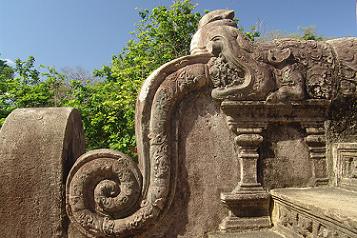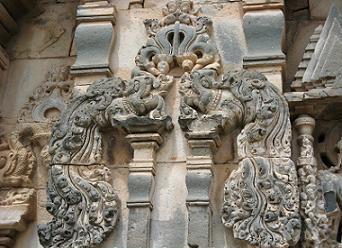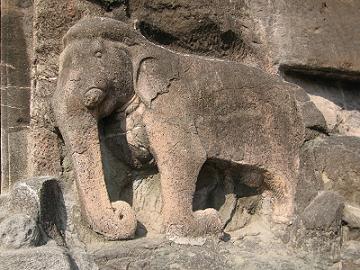Since the pre-Vedic era, the ‘Idea of India’ has been defined by the Monsoons, a season which brings torrential rains to the plains and mountains of the sub-continent. Awaited anxiously by millions, the Monsoons turn India into a soothing, green vision year after year, even as they fertilize its sprawling farms and orchards. No wonder then that India’s agriculture, art, music, dance, literature and religious texts are replete with magical vignettes of rain. Indeed, the Monsoon is likened to Prana, the life-force of fecundity in India’s ornate culture!
May the rains come on time; may the earth bend with the weight of foodgrains,
May this land be free of scourge, may the learned be fearless,
May the poor become wealthy and may all live a hundred autumns,
May the childless have children and those with children have grandchildren,
Lord, give all people a life of well-being….
This is one of India’s oft-recited Vedic prayers. It is counted among the ten most powerful prayers of India. Like most others, this beautiful Sanskrit poem refers to rain as the fertilizing power for the land, as well as the promoter of human welfare and the longevity and health of generations of people. This is because Monsoon rains have been the central theme of India’s history from times immemorial.
“Monsoon rains are a unique feature of the Indian sub-continent,” says Dr. Gautama Vajracharya of the University of Wisconsin, Madison, “It is the only country in the world which has the mighty barrier of the Himalayas to block the passage of rain-bearing clouds that bring a magical rain-dance to India in a specific season every year. India is endowed with the largest water-bearing cloud system in the world. It is estimated to be the size of the entire continent of Europe! It feeds innumerable rivers and their huge network of tributaries to fertilize the subcontinent which is called Bharat Varsha – or the Monsoon Island of the Bharatas in religious literature. It is no wonder then, that the ‘Idea of India’ has been illuminated by the literature, art, culture, music, religion and way of life inspired by the Monsoon tradition. Indeed, Monsoons are considered the ‘Prana’ or life-force of India! The Rigveda contains the famous Parjanya Sukta and the Aap Sukta which are recited by priests even today to propitiate rains.”
According to Dr. Vajracharya, this concept of ‘Prana’ as linked with the Monsoons, is expressed in all the three Indic religions – i.e. Sanatan Dharam, Baudh Dharam, Jain Dharam – through sculpture, literature, art, music and dance. To begin with, countless heritage monuments of these religions feature full-bodied men and sensually-endowed women, well-fed animals and richly-plumed birds. Indeed, the sculptures or frescoes of Barhut, Amaravati, Sanchi, Ajanta and Ellora as well as innumerable temples of every historical age show apsaras, celestial beings and godlings as being amply endowed and ornamented with luxuriant hair. Further, even the figures of the Buddha and all Jain Tirthankaras – who were mendicants with shaven heads – as well as Hindu gods and goddesses, are never shown as emaciated or hairless. All these deities are always shown with well-rounded bodies and curly hair tied up in a top-knot or arranged over the shoulders. Similarly, animals – real and mythical – portrayed in sculptures or paintings are ‘healthy’. Moreover, many sculptures show the abundance of fruits and flowers together with the animals. Rarely do we come across an emaciated animal or human being in all the monuments of India because Prana or rain is associated with prosperity in Indian culture.
A close look at some heritage monuments of India proves this point. In the Ajanta caves, the roof of a cave carries frescos of all animals and birds – such as cattle, peacocks, tortoises (the symbol of the River Yamuna), crocodiles (Makara, the mythical crocodile on which the Ganga rides) and elephants – which are associated with rain or water. In the Barhut, Amaravati and Sanchi monuments, the common motifs that illustrate this unflinching devotion to the Monsoons are stylized figures of frogs, (some psalms of the Rigveda and the Atharvaveda are about frogs), Makara, the mythical crocodile, peacocks, swans and cattle as well as men and women who look prosperous. The Kumbha – or the pot of fullness-prosperity – also features with these motifs. Further, there are many references to the Ashwatha or Peepal tree in ancient literature and sculptures as it is considered the symbol of rain. It features in innumerable monuments either with Krishna, Mahavir or the Buddha. Its leaf is a common motif used in all art in India. In fact, in the Hindu tradition of creation, the child Krishna floats on a Peepal leaf in the Cosmic Ocean contemplating the creation of the universe.
In Vedic literature, the name Ashwatha is given to the first month of the Monsoon, though later, this became Ashadha. The holy river Ganga, too, descends to the earth on the tenth day of the month Jyeshtha, just 20 days before the Monsoons bring green magic to India. Indeed, so powerful is this sweeping vision of Prana (Monsoons) that its architectural features like the mythical Makara have appeared in many Asian countries including Sri Lanka, Cambodia, Jawa and Burma. Some interesting facts: Kamadeva, the god of love, carries a flag on which the Makara is resplendent. The zodiacal sign of Capricorn is called Makara in Indian astrology. In jewellery, the Makara Kundala, or Makara-shaped ear ornaments, are worn by Krishna. Makara is also seen as a motif on railings or balustrades or as gargoyles carrying water from a Shiva Linga to a pool outside the temple.
The omnipresence of the Monsoon in Indian culture and religion did not end with the ancient ages. In Medieval India, it took other forms. Sufi philosophy, with its central belief in love between the individual soul and the universal soul (Raise thy veil and thou shall see thy beloved), added a vignette of ‘ethereal romance in the rains’ to the plethora of its images. In Sufi songs and dances, lovers danced and sang in the rains with a riveting abandon. The romance of Krishna and Radha was already enveloped in the rain theme. Around these legends of love and rain, a huge volume of music and poetry was created from the 12th century, beginning with Jayadeva’s immortal Geet Govind. In this poetry, Krishna and Radha met in fragrant, floral bowers on rain-drenched, thunder-lit nights to keep romantic trysts. When Krishna was gone, Radha’s longing was symbolized by passionate prayers for rain and romance. Later, at Emperor Akbar’s court, this passion for rain music reached a crescendo when Tansen (born a Brahmin) and other great musicians composed specific Monsoon ragas or melodies to invite rain. Krishna himself became Ghanashyam or the dark cloud that brings the bliss of rain to a parched land. His mercy was likened to the ‘showers of rain which moisten the soul’. Through the golden age of Islamic architecture and art, Monsoons remained the throbbing heart of Indian life and culture. Classical dance, music as well as folk songs sung by boatmen, farmers and courtesan-singers reflected the longing of India for the enriching Monsoons.
Somewhere along the way, Monsoon ragas found an immortal place in the classical music system of India. Many scholars say that Monsoon ragas were composed by court musicians and then dancers and painters adopted these for their art. The jewel among such musicians was unquestionably Tansen (1506-1589) who was counted among the Navaratnas – nine gems – at Emperor Akbar’s court. Tansen mastered all ragas and created his own Monsoon melodies which are a proud part of India’s music heritage even today. Legend says that he could actually initiate rains when he sang Monsoon ragas like Megh, Megh Malhar or his own composition Mian Ki Malhar. Tansen and the great poet-saint Surdas were close friends and shared their music mastery. Surdas created the Monsoon raga Sur Malhar. His father Ramdas, a learned musician, contributed Ramdasi Malhar to the rich cornucopia of music! Many more Monsoon ragas found expression during this creative age. These were: Madhu Malhar, Mishra Mel Malhar, Dhulia Malhar and of course the gentler Goud Malhar! There were also several varieties of Malkauns, Sarang, Des and other ragas which were specific to the Monsoon.
Soon, a vast body of devotional compositions based on Monsoon ragas became the rage. Surdas and Tulsidas, the great author of the Ram Charit Manas, sang Monsoon compositions to allude to the allegory that just as all rain falling from the skies flows to merge with the ocean, all living beings flow finally into the shining pool of divinity. Meerabai, Kabir, Surdas, his father Ramdas, Tulsidas – and many other poets and saints of the Middle Ages, sang their songs of edgy eroticism in Monsoon ragas whenever they wanted to express longing for the divine soul.
Krishna became the icon of the Raga Megh Malhar and was seen in many paintings as the initiator of the Monsoons! This legend found its way not only into Hindu culture, but also in the Sufi and Sikh thought. A vast number of schools of miniature painting showed Krishna as the central figure of romance who could create the magic of the Monsoon with his flute. Krishna, according to these artists, was the quintessential god of love, romance and benevolence who appeared in the form of rain to ‘shower’ his mercy and love on the world. For example, Guru Arjun Dev, the fifth Guru of the Sikhs, composed his songs to the Raga Megh Malhar for the Guru Granth Sahib. These are accompanied by a beautiful painting of Krishna as the personification of the Raga Megh Malhar, blowing his divine conch to initiate the Monsoons. In this painting, Krishna stands under a cloudy sky, watched by two Gopis, while cranes fly to the safety of their nests as lightning flashes in the sky! Monsoon ragas were illustrated by every school of miniature painting. An outstanding example is the Ragamala series which shows musical modes in a pictorial manner. One of most beautiful paintings in this series is Raga Megh by Madho Das of Narsinghgarh. It is presently on view at the National Museum, New Delhi
Millenniums have passed. Since time immemorial, India has collected a resplendent treasure of art, architecture, music, dance, culture and literature based on the theme of the Monsoons. What is more, additions to this verdant pool of concepts continue to be created. Even today, the Monsoons remain the scintillating theme of India’s economy, religion, culture and art.
1. Translation of the Parjanya Sukta, from the Rigveda, which is recited in Monsoon ragas with specific metres:
“Then the winds blow…
Then the lightning falls…
Then, the flora sprouts and grows
Then the space overflows,
Then the land prepares for the welfare
When Parjanya the Rain God protects the earth by waters!”
Rigveda 8.53 Parjanya Sukta
2. Translation of the Aap Sukta from the Rigveda also sung to Monsoon Raga with specific metres.
The waters that rain in the skies,
The waters that spring themselves from below the earth
And flow in the canals
And go towards the ocean
The waters that are clean and sacred
These goddesses of water may protect me here”
The author was Editor of Femina for 25 years. Vimla Patil is among India's senior most Journalists-Media persons. She excels in writing lifestyle pieces, women's concerns, travelogues, celebrity interviews, art-culture pieces about India.
Also read:
1. Monsoon Ragas
2. Seven Sacred Rivers

Bharatvarsha Makara sculpture |

Bharatvarsha Makara with peacock tail at Lakuddi near Gadag, Karnataka |

Bharatvarsha Ajanta Elephant |

Bharatvarsha makara kundala on Vithoba at Pandharpur Maharashtra |